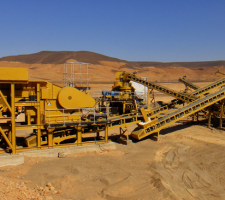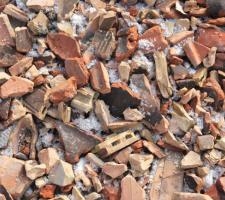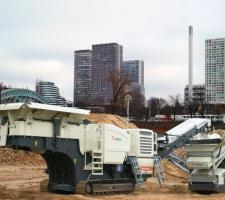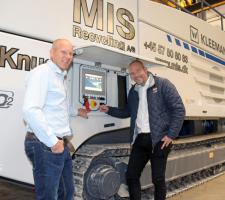
Customer confidence in the quality of recycled aggregates remains an issue. However, changing legislation, social consciousness, plus new research and innovations are driving the adoption of more sustainable construction methods. Liam McLoughlin reports.
There is a historic problem around the perceived poor quality of recycled aggregates, according to UK-based
The Leicestershire company’s MD Richard Dolman says that you get a variant out of the recycling process of what you put into it. He adds that the big challenge is customer confidence in the quality of the product and that AR looks to make a far higher grade of recycled aggregate than normal to address the issue.
“Without removing the dirt, the end product is going to be inferior,” says Dolman. “This has to an extent warped the entire perception of the aggregates recycling industry so it’s something AR Aggregates is keen to put to an end.”
AR Demolition launched an ‘urban quarry’ in Leicestershire at the start of the decade. Its sister company AR Aggregates provides a dedicated crushing and screening operation that operates alongside the company’s demolition business.
Two years ago the company invested in an impact crusher which it now uses rather than a traditional jaw crusher. Such machines have been around in the quarrying industry for a long time but Dolman says they have never been used in demolition and recycling until now. He adds that the impact crusher is capable of crushing a wider variety of materials, more finely and with less waste.
“Traditionally, demolition recycling might only have produced crusher run 6F2 and 6F5 aggregates,” says Dolman. “We are able to make high-grade, clean and single-size end products such as sand, 10mm clean, 20mm clean and certified materials for use in construction products.”
AR recycles aggregate materials from a range of sources including utility contractors, local authorities that are carrying out footway and road repairs, demolition contractors, or from simple groundworks.
Recycled and secondary aggregates are making a larger contribution than ever to the UK’s construction industry, according to Clayton Forsythe, comminution application specialist at
“The range of both natural and recycled aggregates available in the UK is diverse, including crushed rock from quarries; sand extracted from mines; marine-dredged aggregates; and by-products from the metal processing industry,” says Forsythe.
He adds that, while an abundance of primary aggregates can be sourced, changing legislation and social consciousness are driving the adoption of more sustainable construction methods, including the use of recycled materials. For instance, demolition waste is recycled for use in the manufacture of concrete products and paving for housing projects. Demand for these recycled materials in the UK’s aggregates market increased by 18% between 1990-2015 - approximately three times higher than the European average.
Produced during the demolition of buildings, demolition waste typically includes concrete, bricks and plastic, as well as steel from reinforcement bars used to strengthen concrete floor beams. Forsythe says that, to free the steel that is enclosed in the concrete, the demolition waste is generally crushed before the metal is removed by magnets. The waste can subsequently be used to produce particular aggregate sizes for use in concrete production and applications such as backfill and asphalt for roads
“To meet the quality standards required for recycled materials, selecting the right processing equipment is essential,” Forsythe says. “Crushers must accommodate the various feed materials and be able to apply a high crushing force to process each of these.”
Industrial waste such as slag, the by-product from the production of metals such as steel and copper, can also be recycled. However, Forsythe says that even after processing, it may still contain uncrushable elements, such as solid steel pieces, that can damage crushing equipment.
Often uncrushable material is embedded inside the material feed. At times this becomes trapped in the crushing chamber, causing unplanned downtime, loss of production, damage to equipment and safety risks to the maintenance personnel who remove it.
Jaw crushers with hydraulic adjustment include a toggle plate which is designed as the weak point on the equipment, thus minimising the risk of damage. This will bend or break before damage is done to essential parts of the machine such as the main shaft, hydraulics or bearings. Forsythe says the Weir Minerals Trio CTHT crusher series, for example, features a hydraulic toggle relief system which makes it ideal for use in the most rugged applications.
“When uncrushable material enters the chamber, the relief cylinders open and retract automatically,” he adds. “Displacement sensors monitor the position of the relief cylinder and once the uncrushable material is no longer present, it resets to its original position.”
If the crusher opens to its maximum limit and the uncrushable material has not cleared, the control system will automatically stop both the crusher and the hydraulic system to prevent any damage to the equipment. In addition, the feeder can be set up to stop automatically in this situation, thus halting the material feed to the crusher. To prevent the crusher from constantly opening and closing, the relief cylinder pressure can be matched with the strength of the material being processed.
Worldwide, some 40 billion metric tonnes of sand and gravel are used up every year.
During the same time span in Germany, demolished buildings and infrastructure leave behind around five million metric tonnes of fine-grained building rubble. To date, it has ended up in landfills or was used in road construction; upcycling was unheard of.
These facts have prompted German research organisation the Fraunhofer Institute to launch a project called BauCycle to recycle construction waste. Its aim is to transform this mix of minerals into a sustainable resource and demonstrate potential applications in construction. One specific target is to recycle particles of mineral construction waste measuring less than two millimetres in diameter. To do so, the researchers say they are developing innovative sorting processes and high-quality building materials. And to cover the entire value chain, they also plan to set up a dynamic market platform where raw materials are traded as commodities.
“Building sand is not superabundant; in Europe, for example, sand is in short supply in Sweden and France,” says Fraunhofer Institute for Building Physics (IBP) scientist Dr. Volker Thome, the project’s manager. “The conventional method of treating rubble is to crush it. Components of less than two millimetres are sieved out and end up in landfill. If this fine-grained building rubble – which consists mainly of sand-lime bricks, bricks, concrete and small amounts of gypsum – were to be recycled, this could redress the sand shortage over the long term.”
He adds that the first step is to sort the rubble’s heterogeneous content. Gypsum particles have to be selectively separated – they are decisive to the concrete fraction’s recyclability.
The researchers developed an opto-pneumatic detector that enables fine fractions to be separated on the basis of the colour, brightness and chemical composition of the particles; it is even capable of distinguishing sulphates from silicates.
“The waste components are placed on a conveyor belt that transports them past an infrared camera equipped with special filters to detect the various fine fractions. The particles drop off the end of the belt in free fall, past nozzles that shoot the main components into different containers with targeted blasts of compressed air,” says Thome, describing this optical computing technique. Thome and his team say they have succeeded in differentiating one-millimetre particles, and that this technology can achieve a throughput of 1.5 metric tonnes per hour.
The Fraunhofer Institute team will be exhibiting some of their research at the BAU trade fair in Munich from 14-19 January next year.
One of the most recent solutions from Finland-based
Jouni Hulttinen, product manager, Lokotrack mobile crushing plant at Metso, says that 40% of the company’s compact equipment is used for recycling applications, and the focus is towards high-quality end products.
“Currently, the biggest demand is for track-mounted units with impact crushers below 50 tonnes,” Hulttinen adds. “Impactors have a good reduction ratio and can be operated in one stage. Jaw crushers are mainly used in slag recycling operations. Low cost per tonne is essential. Lokotrack LT1213/S impactors are currently our best-selling units for recycling applications.”
As the units operate at construction sites with limited space and are often moved from site to site, they must also be easy to operate and transport. The compact Lokotrack Urban is easy to move around within the site and can be ‘packed up’ for transportation in 15 to 30 minutes.
Concrete and asphalt are the most recycled materials, followed by bricks, but with less importance because they consist of rock and sand, according to Jouni Mähönen, Metso VP direct sales, aggregates equipment.
He adds that concrete is easy to recycle, because the bond between rocks and hardened cement is weaker than the bond between rock minerals. Cement breaks into very fine products and coarser rocks remain their original size up to 12-32 mm. This rock is basically clean, except for some trace of cement. This type of recycled aggregate can be reused in new concrete and asphalt production.
“The more we learn from the use of recycled aggregates, the more proactive we can be in developing our standards related to their use,” says Mähönen.
German company Simmerather Recycling says it has found a successful operational model by combining recycling with quarrying of limestone. Both jobs can be executed with one flexible machine, Metso’s Lokotrack LT1213 impactor plant.
Simmerather Recycling is based in the North Rhine-Westphalia countryside, close to the Belgian border. With a workforce of around 30 employees, the company processes recycling materials collected from the region around the town of Simmerath.
In addition, the company processes limestone in the nearby quarry. The approximate recycling amount per year is 50,000 tonnes and quarrying is 100,000 tonnes.
“Flexibility and quality are the main factors securing cost-efficient operation for us. In processing of recycle materials, we emphasise high quality,” said Simmerather Recycling MD Stephan Braun. “When having a break in recycling, we can transport LT1213 easily to a nearby limestone quarry for aggregates production.”
Simmerather Recycling is certified to the highest RCL1 level with its recycle crushing end products. According to the laboratory tests, the crushed and screened materials can be used widely. Its main particles to recycle are asphalt, concrete and other types of demolition debris. The materials come from reserves collected by Simmerather and other companies.
The basic end products crushed with the LT1213 impactor plant include 0-32 mm- and 0-40 mm-sized grades. The main areas of use are to create waterproofing and road basement layers.
Concrete and asphalt recycling is a growing trend in markets such as the US, according to Mellot Company, a Metso distributor based in Warfordsburg, Pennsylvania. Traditionally, such materials were disposed of at landfills after being removed from parking lots or construction sites, but recycling changed that by enabling them to be reused. In the early days of recycling, reuse was almost solely as fill product due to issues of quality and gradation irregularity. However, Mellot Company says that today recycled concrete and asphalt can be crushed into forms that are usable in a breadth of industry applications.
It adds that advances in equipment and technology have enabled more comprehensive crushing of a broader range of concretes.
“Steel remnants are now removed with less manual labour, and materials ranging from jointed plain pavement, to jointed reinforced pavement, to continuously reinforced pavement, can all be crushed given the appropriate equipment,” the company states in a blog post.
Asphalt recycling is also increasingly common in the US. According to the Federal Highway Administration (FHA), over 80% of asphalt removed from roads is recycled, partly due to its functionality.
“Recycled asphalt product (RAP) is now routinely accepted in asphalt paving mixtures as an aggregate substitute and as a portion of the binder in nearly all 50 states,” the FHA comments. “Recently developed technology has even made it possible to recycle 90-100% recycled asphalt product in hot mix.”
While recycling has improved over the past few decades in terms of functionality of the material, the Mellot Company says that some limitations remain.
First, while the gradation control of recycled materials compares favourably to the gradation quality of virgin materials, abrasion does tend to be different. Additionally, there have been prior instances of contaminants found in recycled materials although the Mellot Company says that, with adherence to proper processes and the use of improved technologies, this is very unlikely.
The Danish recycling market has been experiencing a major boom in recent years and locally based MIS Recycling A/S says it is reaping the benefits of this trend. The company has been actively involved in the processing of residual construction materials for the last 20 years.
To meet what it says is huge demand in the country, MIS now operates 10 impact crushing plants from
MIS processes around 3 million tonnes of residual construction materials and 100,000 tonnes of natural stone per year in Denmark. One of the most frequent applications is the processing of asphalt. The impact crushing plants crush RAP into grain sizes of 0-6mm and 0-20mm. The final product is returned to the asphalt production cycle. Occasionally bricks, concrete and track ballast are also processed. The crushing and screening plant are transported straight to the desired location, remaining on site for one to two weeks, depending on the size of the project.
The next few years are expected to see stricter regulations on the use of screening and crushing plant being implemented in the city centres of Copenhagen, Arhus and Odense. As it geared up for this development, MIS says it was important that the two new Kleemann MR 130 Zi EVO2 plant met the exhaust emissions standard Tier 4 Final. The
Kits Contractor is a Swedish company established in 2011 whose main business areas are recycling construction waste in addition to blasting. Since 2014 it has been using the Transformer D-Series range of attachments from Finland-based
The Transformer D-Series is designed for a range of precision screening and material processing applications.
“We use the material (transformed by the ALLU equipment) on different job sites, although we do sell it to other companies as well,” says Kits Contractor founder Johan Kits. “Mostly the buyers of the material are other contractors and they use it mostly for landscaping projects. But a lot of material we use is for ourselves.”
ALLU provides both the Transformer D and DL-Series which comprise an excavator/ loader/ tractor mounted attachment which screens, crushes, aerates, blends, mixes, separates, feeds and loads materials.


















